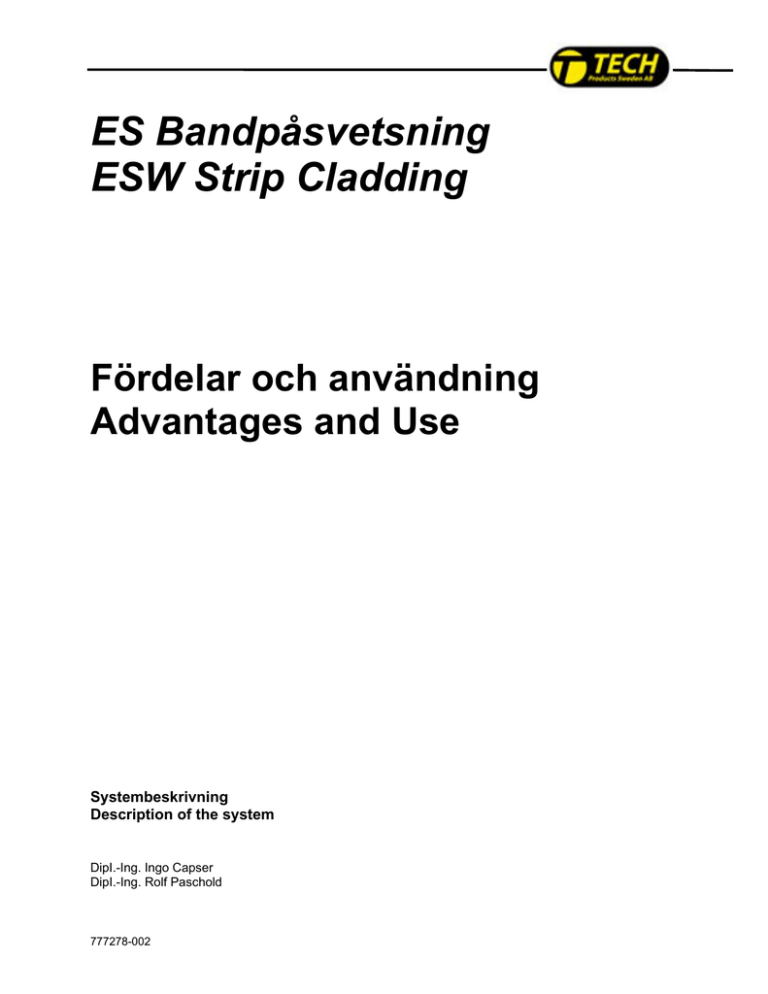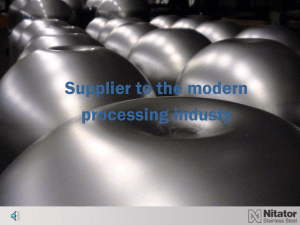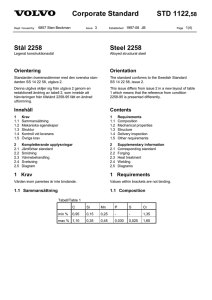ES Bandpåsvetsning Fördelar och Användning (pdf)
advertisement

ES Bandpåsvetsning ESW Strip Cladding Fördelar och användning Advantages and Use Systembeskrivning Description of the system DipI.-Ing. Ingo Capser DipI.-Ing. Rolf Paschold 777278-002 Påsvetsning med bandelektrod enligt Elektroslaggsvetsmetoden - (RES) - Uppbyggnad av anläggningen - En anläggning för denna process motsvarar i allt väsentligt en anläggning för bandpåsvetsning med UP-metoden. Metoden kräver dock en tekniskt något mer avancerad utrustning, t.ex. för bandsvetshuvudet. 1 . Svetsutrustning I Svetsautomat Hit hör de för svetsprocessen nödvändiga mekaniska och elektriska komponenterna. 1.1 Bandmatningsenhet För avrullning av bandet från trumman samt frammatning till svetsstället krävs kraftiga drivmotorer, t.ex. ESABs VEC-motorer. Detta gäller särskilt vid användning av breda bandelektroder. 1.2 Svetshuvud (RES) De i sidled ställbara styrrullarna och den räfflade matarrullen på svetshuvudet garanterar en optimal och störningsfri matning av bandelektroden fram till kontaktdonet. Flata strömkontaktbackar anpassade till aktuell bandelektrod skall användas. Kontaktdonets framsida består av flera fjädrande kontaktfingrar som trycker på bandet och därmed åstadkommer en jämn strömövergång till hela bandbredden. Kontaktdonets baksida består däremot av en kompakt vattenkyld enhet med genomgående kontaktplatta. Detta eftersom den är utsatt för direkt värmestrålning från det icke täckta slaggbadet. 1.3 Hållare för bandelektroder Svetsbanden levereras vanligen i rullar, som vid bandmåttet 60 x 0,5 rnrn normalt väger 30-60 kg. Hållaren på svetsutrustningen måste anpassas till bandrullens vikt. 777278-002 2 SE 1.4 Pulvertillförsel och pulveruppsugning Från en behållare tillförs pulvret framför bandelektroden, sett i svetsriktningen. Härigenom bildas bakom elektroden ett öppet slaggbad. Den resulterande höga temperaturen ger slaggbadet en bättre elektrisk ledningsförmåga och därmed också en ljusbågsfri process. Icke nedsmält svetspulver kan med pulveruppsugaren återföras till behållaren och återanvändas. 1.5 Styr- och reglerenheter För styrning och övervakning av svetsprocessen krävs en noggrann elektronisk utrustning, t.ex. ESABs transistorbestyckade manöverlåda PEH som möjliggör förval av parametrar. 1.6 Magnetutrustning Svetsbadets geometri kan påverkas med hjälp av externa elektromagneter. Magneterna placeras på ömse sidor om svetshuvudet och med resp. magnetflöde så orienterat att det önskade magnetfältet skapas. 2. Svetsströmkälla Processens energiförsörjning sker via automatlikriktare med för processen nödvändiga prestanda. Likriktarens statiska karakteristik, med elektroden ansluten till pluspolen, är genom den tillämpad regleringen lätt fallande till konstant. 3. Mekaniseringsutrustningar Hit räknas maskiner och utrustningar som är nödvändiga för svetsrörelsen och för justering av svetshuvudets inställning. 3.1 Svetsrörelse Svetsrörelsen kan åstadkommas genom att svetsutrustningen flyttas utmed arbetsstycket med hjälp av traktor, balkgående vagn, svetskran o.s.v. Alternativt kan svetsutrustningen vara stationär medan arbetsstycket förflyttas med svetshastighet med hjälp av rullbockar, lägesställare eller dylikt. 777278-002 / 2003 3 SE 3.2 Justeranordningar Svetshuvudets läge måste kunna justeras manuellt eller med hjälp av motordrift. Vid svetsning på större cylindriska arbetsstycken kan materialtillförseln ske spiralformigt eller med stegvis sidförflyttning efter varje fullbordat varv. Proceduren kan utföras automatiskt efter programmering med hänsyn till svetsbadets bredd och erforderlig överlappning. 777278-002 / 2003 4 SE - Drift - Följande parametrar skall beaktas vid bandpåsvetsning: 1 . Elektrodinställning Elektroden är vanligen inställd lodrätt mot arbetsstycket. Normalt är elektroden dessutom inställd 90° mot svetsriktningen men denna vinkel kan ändras. Om så sker erhålls ett tjockare svetslager men med mindre bredd. Detta är dock endast möjligt i begränsad omfattning. 2. Avstånd till strömkontaktbackarna Avståndet från underkanten av kontaktbackarna till arbetsstycket uppgår vanligen till ca 30 mm. 3. Pulvermängd Tjockleken på det bildade slaggskiktet bestäms av den tillförda pulvermängden. Är den för stor blir inte pulvret bakom elektroden helt genomsmält. Är den för liten uppstår flera ljusbågar. Normal pulverhöjd är ca 35 mm. 4. Strömstyrka Genom avsaknaden av ljusbåge blir inbränningen och därmed uppblandnigen av nedsmält grundmaterial och tillsatsmaterial ringa. Jämfört med normal UP-svetsning med bandelektroder kan väsentligt högre strömstyrkor användas, t. ex. 1.000 till 2.300 A för band med måtten 60 x 0,5 mm. 777278-002 / 2003 5 SE 5. Svetsspänning Svetsspänningen uppgår till 26-28 V vid 1.250 A, beroende på typ av pulver. Vid för höga svetsspänningar kan ljusbågar bildas (elektroden kommer inte tillräckligt djupt in i slaggbadet) och processen blir ojämn. 6. Svetshastighet Hastigheten väljs efter önskad tjocklek på svetslagret. På grund av den höga strömstyrkan, och därmed högre smältkapacitet, är hastigheterna högre än vid bandpåsvetsning med UP-metoden. Vid en lagertjocklek på 5 mm ligger den – beroende på använt pulver – mellan 18 och 20 cm/min. Tunnare lager (t.ex. 3,5 mm) svetsas med lägre strömstyrka, eftersom för hög svetshastighet leder till bristande kvalité. 7. Magneter (extra utrustning) Vid användning av yttre magneter ökar smältbadets bredd med 1-2 mm, vilket resulterar i ett tunnare påsvetsat lager. Magnetfältet kan ställas in så att ev. asymmetri i svetsbadet utjämnas. Magnetfältet behövs inte vid bandmått upp till 60 x 0,5 mm. 777278-002 / 2003 6 GB Strip Cladding Using the Electroslag Welding Method – (RES) - Building Up the Plant - A plant intended for this process corresponds in all essentials to a plant built up for strip cladding using the SAW method. However, a somewhat technically more advanced equipment is required for this method, for example for the strip welding head. 1 . Welding Equipment I Automatic Welding Machine Here belong all for the welding process necessary mechanical and electrical components. 1.1 Strip Feed Unit Powerful motors are required - for example ESAB‘s VEC drive motors – for unrolling the strip from the drum and feeding it up to the weld place. This applies particularly to wide strip electrodes. 1.2 Welding Head (RES) The laterally adjustable guide rollers and the grooved feed rollers on the welding head guarantee optimal and trouble-free feed of the strip electrode up to the contact device. Flat contact jaws, adapted to the strip electrode in question, are to be used for the current transition. The front of the contact device is provided with spring-mounted contact fingers pressing the strip down, so as to bring about a uniform current transition over the whole width of the strip. On the rear of the contact device the strip welding head consists of a water-cooled compact unit with a through contact pad; this because it is exposed to direct heat radiation from the open slag pool. 1 .3 Strip Electrode Holder The weld strips are usually supplied in the form of rolls weighing 30-60 kg (at a strip dimension of 60 x 0.5 mm). The electrode holder on the welding equipment shall be 0777278-002 6 GB adapted to the weight of the roll. 1 .4 Flux Supply and Flux Recovery From a container flux is supplied in front of the strip electrode, seen in the travel direction. This forms an open slag pool behind the electrode. The resulting high temperature gives the slag pool better conductivity, and with that also an arc-free process. Non-molten flux can be recovered by way of the flux recovery unit, and returned to the flux container for re-use. 1.5 Control and Adjusting Units For controlling and monitoring the welding process, accurate electronic equipment is required, for example ESAB‘s transistor control unit PEH, offering pre-selection of parameters. 1.6 Magnets (Option) The geometry of the weld pool can be influenced by way of external electro-magnets. The magnets are to be placed on either side of the welding head, the magnetic flow so oriented that the desired magnetic flow is created. 0777278-002 / 2003 7 GB 2. Welding Power Source The power supply for the process takes place by way of automatic rectifiers with for the process necessary performance. The static characteristic of the rectifiers, the electrode connected to the plus pole, is by the applied regulation slightly falling to constant. 3. Equipment for Mechanisation Here belong machines and equipment intended for bringing about the welding motion and for adjusting the position of the welding head. 3.1 Welding Motion The welding motion can be effected by moving the welding equipment along the workpiece using a tractor, rail-borne carriage, welding column and boom, etc. Alternatively, the welding equipment can be stationary, while the workpiece is moved at welding speed by way of a roller bed, positioner or the like. 3.2 Adjusting Devices It must be possible to adjust the position of the welding head, either manually or by motor drive. When welding on large cylindrical workpieces the feed of material can either be done helically or by lateral step-by-step movement after each turn. This procedure can be done automatically after programming with regard to the width of the weld pool and the required overlapping. 0777278-002 / 2003 8 GB - Operation - At strip cladding the following parameters are to be considered: 1 . Electrode Adjustment The electrode is usually positioned perpendicularly to the workpiece. Normally it is also adjusted 90° towards the weld direction, but this angle can be changed. If so, a thicker layer is achieved, but not so wide. This is only possible to a limited extent. 2. Distance to the Contact Jaws The distance between the lower part of the contact jaws and the workpiece usually is some 30 mm. 3. Flux The thickness of the slag layer formed is due to the amount of flux supplied. Too much flux means that the flux behind the electrode will not melt completely. Too little flux means that arcs will form. The normal height of the flux layer is some 35 mm. 4. Amperage The absence of the arc means that the penetration is not so deep, and by that the mixing of the molten base material with the filler material will be poor. Compared to ordinary SAW welding using strip electrodes, considerably higher amperages can be used, for example 1.000 to 2.300 A for strip electrodes of the dimension 60 x 0.5 mm. 0777278-002 / 2003 9 GB 5. Welding Voltage The welding voltage comes up to 26-28 V at 1.250 A, depending on the type of flux used. Too high voltages can result in arcs forming (the electrode does not get deep enough into the slag pool and the process becomes unstable. 6. Welding Speed The welding speed is selected according to the desired thickness of the weld layer. Due to the high amperage, and with that the higher melting capacity, the speed is higher than for strip cladding using the SAW method. At a thickness of layer of 5 mm the speed is, depending on the flux used, between 18 and 20 cm/min. Thin layers (for example 3.5 mm) are welded at lower amperages, as too high welding speed will result in poor quality. 7. Magnets (Option) Using exterior magnets, the width of the weld pool will increase by 1-2 mm, resulting in a thinner weld layer. The magnetic field can be adjusted so as to even out the asymmetry of the weld pool, if any. Magnetic fields are not needed for strip electrodes up to 60 x 0.5 mm. 0777278-002 / 2003 10

